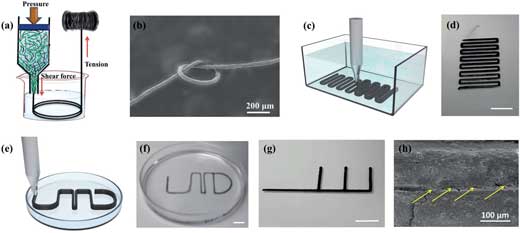| Posted: Sep 25, 2017 | |
Nanocellulose dramatically improves the 3D-printability of carbon nanotubes for wearable electronics |
|
| (Nanowerk Spotlight) Researchers have focused on nanocellulose as a novel biomaterial with industrial and scientific applications, which range from the creation of new kinds of commercially useful materials and uses in medical technology all the way to the food and pharmaceutical industries. | |
| Engineers at the University of Maryland have developed a new use for nanofibrillated cellulose (NFC) by combining it with carbon nanotubes (CNTs) to form strong, conductive microfibers through a 3D-printing process. Associate Professor Liangbing Hu of the Energy Research Center and his colleagues have reported their findings in Small Methods ("Cellulose-Nanofiber-Enabled 3D Printing of a Carbon-Nanotube Microfiber Network"). | |
 |
|
| Schematic to show the CNT–NFC microfiber network formation through 3D printing. Solvent exchange was performed once the NFC-dispersed CNT solution was extruded into the coagulation bath of ethanol, leading to the formation of a stable gel fiber. A dry CNT–NFC microfiber can be obtained after pulling the gel fiber out to dry under tension for tens of seconds. During the process, all the building blocks are highly aligned along the fiber direction. The alignment of both CNT and NFC in microfibers leads to the combination of excellent mechanical strength and electrical conductivity. (Reprinted with permission by Wiley-VCH Verlag) | |
| The team's 3D-printed wood nanocellulose-carbon nanotube microfibers combine high electrical conductivity (216.7±10 S/cm) and mechanical strength (247±5 MPa), which can be potentially used in wearable electronics with high performance and low cost. | |
| "Conventional methods to disperse carbon nanotube in aqueous solution include carbon nanotube surface covalent modifications and organic surfactants," Hu tells Nanowerk. "This either leads to low mechanical strength or poor conductivity. We used nanocellulose particles as both dispersing agent for the carbon nanotubes and as reinforcement in the composite fibers." | |
| The fast and scalable 3D-printing of these microfibers, with their high electrical conductivity and mechanical strength, could significantly lower the cost of fabrication for wearable electronic components such as batteries and capacitors. | |
| This video demonstrates the 3D-printing process. | |
| "Using NFC as a dispersant for nanotube dispersion is easy to scale up, and it holds more advantages than CNT dispersion through chemical modification," explains Yuanyuan Li, the paper's first author. "Firstly, NFC can be extracted from abundant cheap resources, such as wood, cotton, and wheat straw. It is also bioactive because the NFC is biocompatible, and organic solvent is avoided. This makes the dispersion suitable for applications in life science and the disposal is a non issue." | |
| "Secondly" he continues, "the dispersion of CNT is mainly based on absorption, wrapping, and fluctuation of counter ions between the CNT and the NFC. Thus, the electronic structure and conductivity of individual CNT are preserved compared with dispersion by chemical modification. In addition, the NFC remaining in the dispersion is an excellent building block to make strong, lightweight CNT nanocomposites." | |
| A novelty in the team's approach is the use of 3D-printing to achieve one-dimensional (1D) fiber formation. This is achieved based on solvent exchange between ethanol and water. It is well known that CNT is not dispersible in either water or ethanol; that is why the researchers applied the cellulose nanofibers to disperse the nanotubes in water. | |
| As is illustrated in the figure below, the NFC-dispersed CNT aqueous solution was then extruded into a coagulation bath of ethanol, where solvent exchange was performed to form a stable gel fiber. Then the gel fiber was pulled out and dried under tension at room temperature. The shear force introduced through extruding, and the tension applied during drying caused the building blocks to align along the fiber length direction, leading to a highly aligned microfiber. | |
 |
|
| a) Schematic to show the fabrication of the microfiber, where the building blocks were prealigned by extruding into the coagulation and further aligned by tension during drying. b) A knot made from a microfiber showing the flexibility. c) Schematic image shows square-wave structure for 3D printing. d) 3D-printed square-wave structure. e) Designed “UMD” shape structure. f) Optical image of the “UMD” pattern precisely carried out through 3D printing. g) Programmable printed three-layered conductive lines with designed shapes. The scale bars in parts (d), (f), and (g) represent 10 mm. h) SEM image of the 3D-printed pattern showing the good adhesion between layers. The yellow arrows point the interface between two layers. (click on image to enlarge) (Reprinted with permission by Wiley-VCH Verlag) | |
| "By dramatically improving the 3D printability and mechanical/electrical properties of CNT microfibers, we demonstrated that nanofibrillated cellulose is an excellent enabling material for high-performance microfibers for wearable electronics," concludes Hu. | |
 By
Michael
Berger
– Michael is author of three books by the Royal Society of Chemistry:
Nano-Society: Pushing the Boundaries of Technology,
Nanotechnology: The Future is Tiny, and
Nanoengineering: The Skills and Tools Making Technology Invisible
Copyright ©
Nanowerk LLC
By
Michael
Berger
– Michael is author of three books by the Royal Society of Chemistry:
Nano-Society: Pushing the Boundaries of Technology,
Nanotechnology: The Future is Tiny, and
Nanoengineering: The Skills and Tools Making Technology Invisible
Copyright ©
Nanowerk LLC
|
|
|
Become a Spotlight guest author! Join our large and growing group of guest contributors. Have you just published a scientific paper or have other exciting developments to share with the nanotechnology community? Here is how to publish on nanowerk.com. |
|
